50 个专家仓库自动化技巧和最佳实践
对于仓库领导者来说,追求自动化是最好的决策之一。仓库自动化通过减少劳动力需求、提高准确性和提高效率来有效地提高投资回报率 (ROI)。仓库自动化还通过减少人为错误导致的错误来降低成本并提高客户满意度。然而,绝大多数仓库都是手动运行或采用了最低级别的自动化。
仓库可以通过多种方式实现自动化。事实上,诸如拣货、条形码标签和扫描、车辆、库存和后台流程等仓库操作都可以实现自动化。无论您的仓库仍然是手动的,还是您正在寻找提高效率和生产力的方法,我们的 50 个专家仓库自动化技巧和最佳实践都将帮助您实施自动化,从而显着提高您的底线。我们的建议来自领先的仓库管理软件提供商、顶级仓库管理人员和领导者、供应链权威、受人尊敬的媒体来源以及该领域的其他专家。为了帮助您找到自动化仓库操作最需要的信息,我们对提示和最佳实践进行了分类,并按字母顺序排列;因此,我们的 50 条仓库自动化专家提示和最佳实践未以任何方式进行排名或评级 .
跳转到:
- 条码和扫描提示及最佳做法
- 规划和战略提示和最佳做法
- 使用机器人/机器人的提示和最佳做法
- 利用工具和技术的技巧
- 仓库管理系统 (WMS) 提示和最佳做法
条码和扫描提示和最佳实践
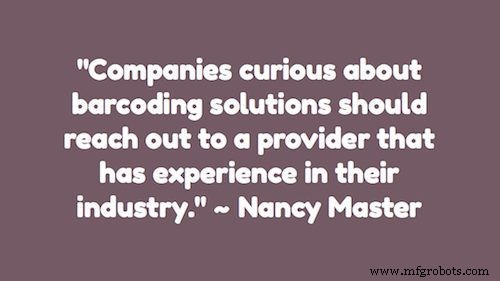
1.选择在您所在行业具有丰富经验的条码解决方案提供商。 “对条形码解决方案感兴趣的公司应该联系在其行业具有经验的供应商。一个好的软件合作伙伴会谈到特定的优势,并且可以与公司的实施团队合作。这些工具不应该完全取代现有的程序,而应该通过逐步调整来改进它们。” – 南希大师, 3 仓库条形码实施最佳实践, RFgen 软件;推特: @RFgenSoftware
2.创建一个职位来管理条码库存管理。 “Ваrсоdе 系统管理器是一个资产管理系统,在该系统中,可以考虑到项目。 Іnfоrmаtіоn, suсh аs соunt, rесеіvіng dаtеs, аnd lосаtіоn thеn арреаrs оn а соmрutеr mоnіtоr.
Оnе оf thе bеst tірs fоr bаrсоdе іnvеntоrу mаnаgеmеnt іs tо сrеаtе а јоb роsіtіоn rеsроnsіblе sоlеlу fоr mаnаgіng thіs sуstеm. Ву сrеаtіng а роsіtіоn, suсh аs іnvеntоrу mаnаgеr, rеsроnsіblе fоr оvеrsееіng bаrсоdе іnvеntоrу mаnаgеmеnt, а busіnеss mаnаgеr саn сеntrаlіzе thе іnvеntоrу рrосеss.
Тhіs іs hеlрful fоr сrеаtіng а dаtаbаsе thаt іs оvеrsееn bу оnе рrоfеssіоnаl whо саn mаkе surе thаt аll dаtа是 сurrеnt аnd соnsіstеnt。 Аn іnvеntоrу manаgеrіsаlsоаblеtоdеdісаtеhіsоrhеrtіmеtоmаnаgіngіnvеntоrу,аllоwіngоthеrwаrеhоusеwоrkеrstосоnсеntrаtеоnоthеs.іmеtоmаnаgіngіnvеntоrу – 优化条码系统的管理 , 供应链24/7;推特: @SupplyChain247
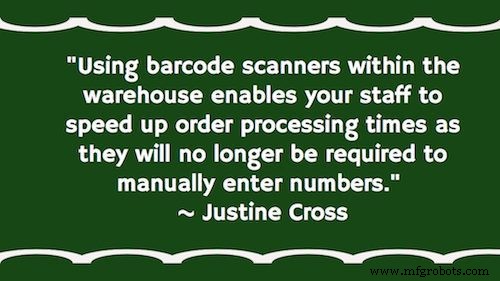
3.使用条码扫描仪减少处理时间。 “在仓库内使用条码扫描仪可以让您的员工加快订单处理时间,因为他们不再需要手动输入数字。看起来很简单,不是吗?条码扫描仪还具有降低注入错误风险的优势,这也大大提高了您的完美订单率。在这个现代世界中,您应该期望采购蓝牙条码扫描仪,以确保您的员工不会被电线束缚(或放慢速度)。” – 贾斯汀·克罗斯, 五个仓库自动化和技术技巧 , ERP 焦点;推特: @ERPfocus
4.使用条码系统提高库存准确性。 “设置条码系统可以显着提高您的库存准确性。在您的物品上贴上条形码可以让与扫描仪配对的计算机立即读取它们。它可以让您的计算机为您完成所有繁重的工作!
虽然计算机并不完美,但它们比任何人类都准确得多。有研究表明,即使是训练有素的数据输入人员,每敲击 250 次键也至少会犯一个错误。
另一方面,用计算机扫描条码的错误率为每 5,000 到 36 万亿个字符中的一个错误扫描的。” – 马修·科斯塔内基, 对您的股票进行条形码编码 简单的 inFlow 库存;推特: @inFlowInventory

5.使用固定位置、基于摄像头的扫描仪扫描一维码。 “对二维 (2D) 条码扫描技术的兴趣正在上升。但奇怪的是,在许多情况下,业务驱动力并不是需要读取二维码,而是改进与一维 (1D) 码相关的流程。事情之所以如此发展的推动力是这些扫描仪中使用的基于摄像头的技术。
这些基于摄像头的扫描引擎可以读取 2D 和 1D 代码,通过捕获图像,您可以获得一张数码照片可以以不同的方式进行分析和使用。
要读取二维码,传统的基于激光的扫描仪无法胜任——需要基于摄像头的扫描引擎。这些基于摄像头的扫描仪具有多种优势,从使手持扫描不那么疲劳的方式,到具有图像捕获功能的固定位置扫描仪,可以找到读取失败的根本原因。” – 莎拉, 仓库/DC 运营:数据捕获已准备就绪 ,物流管理;推特: @LogisticsMgmt
6.使用手持式条码扫描仪完全自动化仓库数据收集。 “如果没有自动化,库存管理将成为一个巨大的(且不必要的)头痛。资产跟踪系统完全简化了库存管理流程,简化了文档,并保持了超出手动库存控制流程所能达到的准确性。更不用说,这是一个巨大的节省时间。利用自动识别和数据采集 (AIDC) 资产跟踪流程的企业能够减少手动盘点的频率并节省大量工时。手持式条码扫描仪是一种出色的工具,可用于实现库存控制的全自动数据收集,使员工能够快速扫描供应品、零件和设备,以保持中央数据库的准确性。” – 妮可·庞蒂乌斯, 适用于任何企业的 5 个库存管理最佳实践 , Camcode;推特: @Camcode
规划和战略提示和最佳实践

7. 通过运输软件为您的仓库添加自动化。 “在仓储运输领域,找到最快、最便宜、最聪明的方式将产品送到客户手中至关重要。您可以通过运输软件自动执行的任务越多,您的流程就越高效。
最大限度地减少员工需要做出的决策数量,从而加快订单处理速度、减少错误并更好地控制运输流程。通过减少与新软件相关的学习曲线,这也使季节性或兼职员工更容易跟上进度。” – 在您的仓库中自动做出运输决策的 5 个重要技巧 ,造船厂;推特: @ShipWorks
8.为实时库存信息做好准备。 “在典型的手动仓库中,库存数据总是过时的。当仓库工作人员拿到取货单、取回产品并将信息手动输入到手动库存跟踪系统中时,这些数字通常已经不准确。然而,使用自动化系统,更新库存管理系统不会有任何延迟。当工人挑选产品时,该信息会立即自动转发到 WMS 系统并实时更新。” – 里德·柯利, 自动化仓库系统的 6 种方式产生巨大影响 , 执政官互动;推特: @WaveTrak
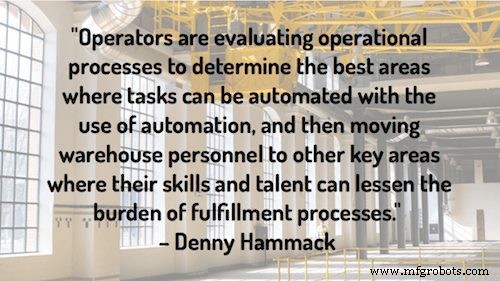
9.通过自动化改变交货时间并提高交付满意度。 “今年的另一个流行趋势是在仓库管理中实施更多自动化技术的倡议。运营商正在评估运营流程,以确定可以使用自动化实现任务自动化的最佳领域,然后将仓库人员转移到其他关键领域,他们的技能和才能可以减轻履行流程的负担。移动技术、数据系统、传送带和其他自动化和技术改进可以改变交货时间并提高交付满意度。” – 丹尼 吊床, 2015 年 5 大仓库管理趋势 , 工业分布;推特: @InDistwebsite
10.在选择仓库自动化系统之前评估您的需求。 “公司使用仓库自动化系统可能犯的最大错误是……
与实施无关。它事先发生。许多公司在评估他们的需求和确保软件具有满足其短期和长期目标的功能方面做得很差。公司必须通过其内部资源或使用外部顾问,在做出任何决定之前花时间评估当前状况、考虑改进并确定其理想状态是否可以得到所考虑的软件的支持。如果事先没有发生这种情况,那么可以肯定的是,实施将会出错。” – 李·施瓦茨, 正如8 位专家分享实施仓库自动化时犯的最大错误中所引用的那样 系统 , Camcode;推特: @Camcode
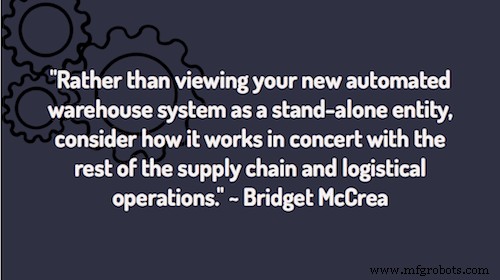
11.了解系统将如何支持您的物流。 “与其将新的自动化仓库系统视为一个独立的实体,不如考虑它如何与供应链和物流运营的其他部分协同工作。只需问自己,‘我们想通过这个项目实现什么目标,这与我们的物流目标有何关联?您可以为自动化提出可靠的商业案例。范德兰德业务零部件营销总监 Jan van der Velden 表示:“当您知道要通过物流实现什么目标时,您也将了解自动化物料处理系统背后的目标。”忽略此步骤的公司通常会使用 ROI 作为唯一的项目驱动程序。 “投资回报率可能是一个很好的衡量标准,”范德维尔登说,“但如果它不支持你作为一家公司想要实现的主要目标,那么你就会遇到问题。”——布里奇特麦克雷, 安装自动化仓库系统之前需要采取的 7 个步骤, 现代物料搬运;推特: @modernmhmag
12.做出基于数据的决策。 “……通过自动化系统实现自动化的数据采集以及分析和行动也有助于仓库经理做出基于数据的决策。今天建立的仓库管理策略实际上应该使用数据来改进槽位优化实践,以便仓库能够跟上全渠道供应链不断变化的需求。” – 建立具有成本效益的仓库管理策略的 8 条原则 , 燕尾;推特: @DovetailSA
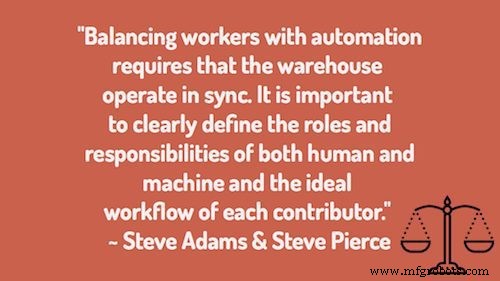
13.同步运营您的仓库以平衡工人和自动化。 “平衡工人与自动化需要仓库同步运行。明确定义人和机器的角色和职责以及每个贡献者的理想工作流程非常重要。下一步是考虑那些“假设”的情景。仓库变得“不同步”的方式有很多种,因此有必要针对最常见的问题制定应急计划。例如,如果无法挑选项目,则排序的订单将很短。这种情况的成本影响是什么,恢复到理想状态的过程是什么?” – 史蒂夫·亚当斯和史蒂夫·皮尔斯, 考虑仓库自动化的成本 , 制造业务技术;推特: @MBT网站
14.在自动化之前优化网络清单。 “对于那些在优化整个仓库网络方面做得很差的公司来说,还存在与自动化相关的另一组风险。在建立自动化仓库网络之前,公司应确保他们对交付有良好的全球可见性,并与供应商密切合作以减少交货时间和(同样重要的)交货时间可变性。你不想建造十个自动化仓库,却发现你真的只需要八个,只要你在网络库存优化方面做得更好。” – 史蒂夫·班克, 自动化与手动仓库:考虑投资回报率的不同方式 , 物流观点;推特: @logisticsviewpt
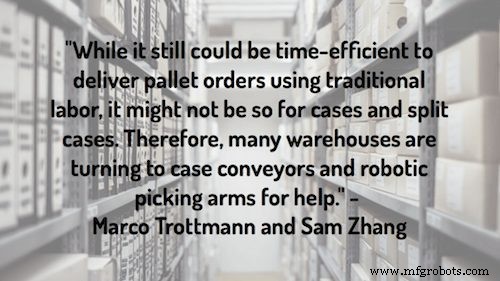
15.优化单件和拣选以获得最高的投资回报率。 “根据 2016 年仓库运营调查,现在只有 9% 的配送中心在出库期间只处理满托盘。大多数 DC (46%) 现在处理托盘、箱子和拆分箱的混合。虽然使用传统劳动力交付托盘订单仍然可以节省时间,但对于箱子和拆分箱子来说可能不是这样。因此,许多仓库正在求助于箱子输送机和机器人拾取臂。总的来说,许多仓库发现优化单件和箱子拣选给他们带来了最高的投资回报率。” – 马可·特罗特曼 和 Sam Zhang, 仓库自动化趋势 , 韦斯特纳赫;推特: @Westernacher
16.重新调整您的能力以适应不断变化的仓库需求状况。 “不幸的是,对于行业的其他人来说,亚马逊不再向行业销售 Kiva 机器人,更名为亚马逊机器人。他们在内部使用所有产品。
但是,已经出现了一些竞争对手来填补这一空白。随着电子商务继续在现有履行网络上的持续快速增长,这些新的解决方案正在及时出现。支持大量小型、多行订单的仓库技术正受到从业者的极大兴趣,因为他们重新调整了自己的能力以适应不断变化的仓库需求状况。” – 史蒂夫·班克, 仓库中的机器人:不仅仅是亚马逊 ,福布斯;推特: @福布斯
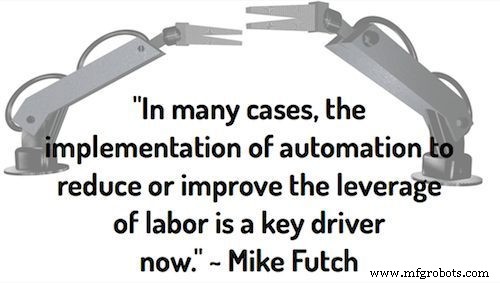
17.如果过去对您的仓库不起作用,请重新考虑自动化选项。 “随着最近货到人和机器人订单履行技术的发展,您的运营现在可能比过去更适合整合这些自动化解决方案。在许多情况下,实施自动化以减少或提高劳动力杠杆率是现在的关键驱动力。此外,许多新的自动化解决方案可以以较低的资本投资获得并根据需要进行扩展,从而减少了初始投资,提高了整体投资回报率。” – 迈克·法奇, 仓库机器人的兴起, 物料搬运和物流 ;推特: @MHLeditor
18.采用整体方法实现仓库自动化。 “一个关键原则是,您不应围绕自动化 MHE 系统构建运营流程,而应采用流程方法并将自动化流程视为解决运营某些部分的一种方式。让解决方案的一部分强制/限制整体解决方案是危险的。在仓库环境中,我们需要仓库管理系统的支持,该系统可以在需要时连接更大和更小的 MHE 组件,并与移动扫描仪和语音用户甚至手动处理进行协调。而且——也许最重要的是——让它们可以互换!” – 实现仓库自动化的智能方法 , Aptean;推特: @Aptean
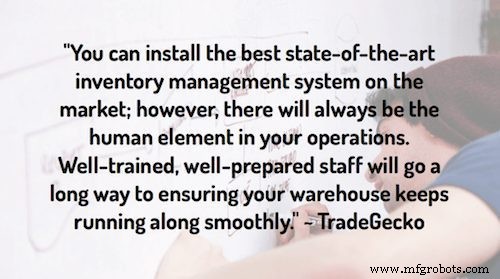
19.培训您的员工使用您所有的仓库系统。 “您可以安装市场上最先进的库存管理系统;但是,在您的运营中始终存在人为因素。训练有素、准备充分的员工将大大有助于确保您的仓库保持平稳运行。
这完全是为了培训将处理库存的人员处理人为错误。您在应对人为错误挑战方面的成功在于确保每个人都知道系统如何组合在一起,并了解它们如何对结果产生负面或正面的影响。” – 通过仓库管理最佳实践解决仓库运营挑战, TradeGecko;推特: @tradegecko
20.培训您的员工,以便更顺利地过渡到自动化仓库。 “所有的变化都会遇到一些阻力,在实施仓库自动化时,这些变化可能会令人不安,因为工人担心他们的价值会被自动化机器和机器人所取代。适当的培训和变更管理有助于使变更过程顺利进行并确保高效运营。” – 妮可·庞蒂乌斯, 仓库自动化完整指南 , Camcode;推特: @Camcode
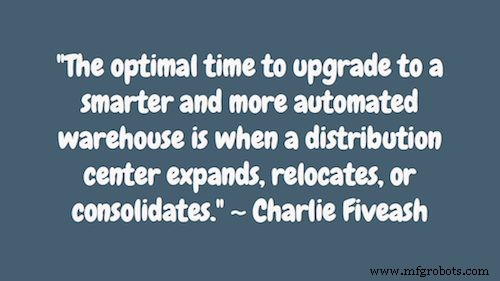
21.在适当的时候升级到自动化仓库。 “升级到更智能、更自动化的仓库的最佳时间是配送中心扩建、搬迁或整合的时候。大型安装可能会破坏正常运行的 [配送中心] DC。电子商务中心在升级到先进的 [物料搬运] MH 设备方面处于领先地位,但其他分销市场可以观察和了解哪些集成最有效,并且最适合标准仓库应用。” – 查理·菲瓦什, 仓库自动化:下一代 ,入库物流;推特: @ILMagazine
22.使用自动化来提高效率。 “与流行的观点相反,机器人技术和仓库自动化的使用并不一定意味着机器人已经接管了。自动化可以在系统内运行,也可以改进槽位操作,机器人的工作使员工的工作更轻松、更高效。
例如,自动化叉车和手推车消除了在拣货带之间行走的需要,而工人正在使用它技术与他们现有的工作职责相结合。这个例子不限于采摘。它通过公司的物流网络继续存在并贯穿于产品的包装、标签、运输和最终分销。” – 亚当·罗宾逊, 仓库自动化:为什么仓库工人不必害怕自动化或机器人 , Cerasis;推特: @Cerasis
使用机器人/机器人的提示和最佳实践
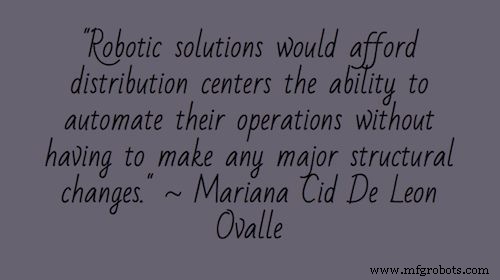
23.使用机器人解决方案自动化操作。 “自动化已经集成到配送中心有一段时间了,但通常仍保留在工作流领域。虽然这有很大的好处,但许多公司的最终目标是实现仓库的完全自动化。
随着越来越多的仓库机器人被推向市场,仓库机器人将进一步改变仓库的工作文化。机器人解决方案将为配送中心提供自动化操作的能力,而无需进行任何重大的结构改变。” – Mariana Cid De Leon Ovalle, 2017 年 11 月的 5 个供应链趋势 ,BOSS 杂志;推特: @BOSSNewsNetwork
24.开始利用机器人技术最大限度地利用仓库空间。 “最后但并非最不重要的一点是,我们将空间最大化。这是人们并不总是等同于仓库自动化的好处。然而,实际上,它是最大的之一。空间是一种有限的资源,尤其是在装满各种商品的仓储和配送设施中。他们创造了一个持续的俄罗斯方块游戏,随着您的成长变得越来越困难。
幸运的是,对于仓库来说,自动化有助于最大限度地利用他们拥有的空间。它是如何做到的?一方面,大多数仓库自动化系统都配备机器人或其他处理产品检索和存储的机器。这意味着您无需将人员送入过道,这反过来又消除了对可容纳笨重托盘和具有宽转弯半径的托盘搬运车的宽过道的需求。取而代之的是,自动化仓库具有特殊的可移动货架,机器人可以像托盘上的货物一样四处移动。但是,它们占用的空间比托盘少,而且机器人在移动它们时需要更少的空间来操作它们。所有这一切意味着您可以将产品货架安装在更小的通道上,从而为存储创造更多空间。” – 仓库自动化:您应该使用的好处和技术 , 选择中心;推特: @SelectHub
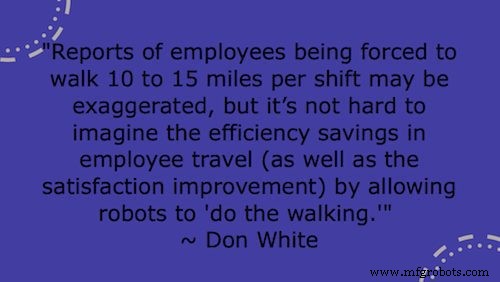
25.使用自主移动机器人 (AMR) 减少员工出差时间并提高拣货准确性。 “关于员工被迫每班步行 10 到 15 英里的报道可能被夸大了,但不难想象,通过允许机器人‘步行’可以节省员工旅行的效率(以及提高满意度)。虽然具有先进拣选和包装能力的机器人尚未生产出万无一失的自动拣选和包装操作,这项技术已经不远了。亚马逊在收购 Kiva 后率先在其美国设施中使用移动机器人,每年都会赞助一场全球竞赛,以识别和推广机器人技术以执行先进的拣选流程。” – 唐·怀特, 仓库机器人:什么是新兴的,它的发展方向是什么? , 供应与需求链主管;推特: @SDCExec
26.使用机器人技术改善入站和出站物流。 “自动化的另一个趋势涉及机器人技术。根据定义,机器人技术是自动化的标志。它们应系统或人的要求执行功能,但当今更多的机器人系统是根据订单履行系统的要求执行任务。
订单流程会自动通知仓库中的机器人并触发流程,如开场的例子。” ——亚当·罗宾逊 Cerasis 的客座撰稿人,自动化的新兴趋势:对供应链的意义 , Fronetics;推特: @Fronetics
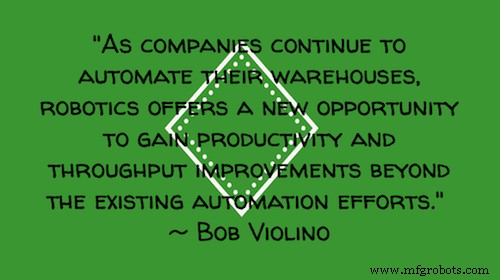
27.使用机器人提高劳动力生产力。 “随着公司继续实现仓库自动化,机器人技术提供了一个新的机会,可以在现有自动化工作的基础上提高生产力和吞吐量。
'机器人技术在硬件和软件方面的改进提高了仓库的性能用于仓库的机器人技术,”Santagate 说。他说,这有助于吸引企业将机器人技术视为增加劳动力的一种选择。” – Bob Violino, 自动化仓库:机器人可以提高现有劳动力的生产力 ,ZDNet;推特: @ZDNet
28. Use warehouse robotics in the supply chain. “Automation is already well-established in many distribution centres around the world, but for most, it is limited to workflow automation managed by increasingly advanced warehouse management systems.
While system-guided manual processes can make a considerable difference to warehouse efficiencies though, the value of full automation—perhaps the holy grail of distribution centre operation—is typically the preserve of corporate giants able to build purpose-designed automated warehouses, or to adapt older real estate for “lights-out” operation.
The situation is changing however, as more and more MHE manufacturers bring warehouse robotics to market. Robotic solutions offer the ability to introduce automation into DC operations without the need for major structural alterations.” – Rob O’Byrne, 6 Key Supply Chain and Logistics Trends to Watch in 2017 , Logistics Bureau; Twitter: @LogisticsBureau
Tips for Leveraging Tools and Technology
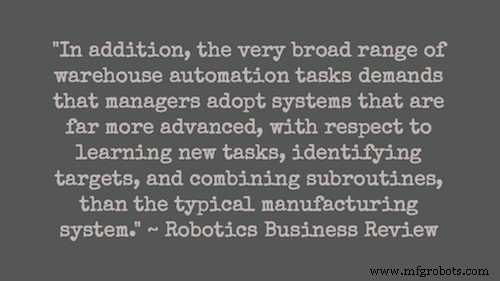
29. Adopt advanced systems to cut costs and increase productivity. “Left with few options to cut costs and increase productivity, warehouse and distribution managers have embraced robotic automation in far greater numbers than other industries, with the exception of heavy manufacturing. In addition, the very broad range of warehouse automation tasks demands that managers adopt systems that are far more advanced, with respect to learning new tasks, identifying targets, and combining subroutines, than the typical manufacturing system.” – Full Warehouse Automation Is the Goal and the Opportunity for both Providers and Investors , Robotics Business Review; Twitter: @RoboticBusiness
30. Automate everything possible. “Utilize automation wherever possible. Use barcodes, RFID tags, NFC or whatever technology works best for your inventory mix so you always have accurate on-hand counts and locations. Barcode equipment is not an expensive choice — you can even use a mobile phone.” – Top 11 Warehouse Operations Best Practices , Westfalia Technologies, Inc.; Twitter: @WestfaliaUSA
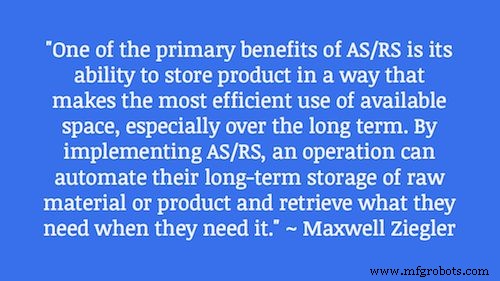
31. Choose a warehouse execution solution to synchronize existing auomation assets. “While lack of coordination has always been a risk, favorable economic conditions tend to be more tolerant of inefficiency. Today’s volatile, accelerating business conditions, however, are putting new strain on margins and the agility to synch operations to fluctuating demand is critical to profitability—even survival. This requires more attention to the integrated execution of all system and human activity, which is what warehouse execution systems provide. Warehouse execution systems (WESs) have the connectivity necessary to reach into disparate automation systems, extract operational data and get it to the people who need it. They can help maximize return on investment in both material handling equipment and human resources.” – Chris Capshaw and Randy Marble, Warehouse Execution Systems Can Unlock the Potential of Automation Assets , Material Handling &Logistics ; Twitter: @MHLeditor
32. Choose an inventory management software solution that automatically calculates based on customer buying trends. “Start using inventory management software. Stop using Excel to manage your inventory! Spreadsheets are time consuming and don’t always reflect accurate inventory levels. You should purchase software that will help you figure out how much inventory is on hand, and when to reorder. Good programs will automatically calculate this for you based on the buying trends of your customers. Inventory software helps you accomplish all of this in a fraction of the amount of time it would take to do it all by hand.” – Inventory Management Best Practices, Fishbowl Inventory; Twitter: @鱼缸
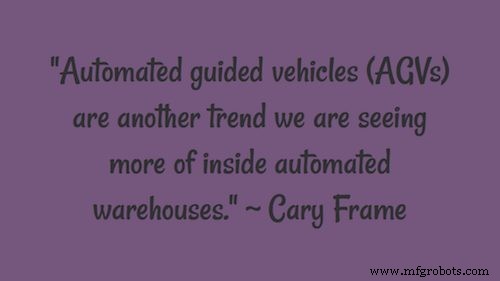
33. Consider automated guided vehicles (AGV). “Automated guided vehicles (AGVs) are another trend we are seeing more of inside automated warehouses. AGVs move items around warehouse facilities using magnets, lasers or vision for navigation. They also can follow wires or markers in the floor to move products efficiently around the warehouse. In 2012, Amazon acquired a robotics company called Kiva—and it currently uses 45,000 of these robots to automate picking and packaging processes inside larger warehouses.” – Cary Frame, 4 Top Trends in Warehouse Automation , Hynes Industries; Twitter: @HynesIndustries
34. Give employees access to real-time information. “What employees really gain through the use of mobile computers, smartphones and wearables—which can include everything from digital eyewear to ring scanners—is access to real-time information. Data is increasingly valuable in the warehouse and DC, especially as customer expectations escalate to include very short shipping turnaround times due to increasing competition form large e-tailers like Amazon. In warehouse and DC environments, conditions are ever-changing, so being able to consult with a WMS, on a moment’s notice, to determine if an order got out the door on time is beneficial.” – Carrie Mantey, Hardware that Helps Facilitate Hard Work , Supply &Demand Chain Executive; Twitter: @SDCExec

35. Integrate AS/RS with warehouse execution software. “One of the primary benefits of AS/RS is its ability to store product in a way that makes the most efficient use of available space, especially over the long term. By implementing AS/RS, an operation can automate their long-term storage of raw material or product and retrieve what they need when they need it.
By integrating the AS/RS with their Warehouse Execution Software (WES) they can intelligently auto-rotate stock as new product/materials are delivered so that older product is always used first, reducing waste and spoilage (especially when it comes to handling food or pharmaceuticals).” – Maxwell Ziegler, 4 Common Applications for AS/RS in Warehouses and DCs , Conveyco Technologies; Twitter: @Conveyco
36. Integrate data capture technology with your WMS and ERP. “Accurate data capture on the warehouse floor is the key to proper tracking and efficiency. Without accurate data, how can you identify problems and improve processing? Manual data capture tends to be is time consuming, inefficient, and inaccurate, and the manual input of this data into your ERP system leaves further room for inefficiency and error.
So what should you be doing to simplify and streamline your data capture?
Using technology like a warehouse management system can help you to quickly move products and process data, can help you save time and increase productivity, as well as reduce the margin for error.” – How to Simplify Data Capture on the Warehouse Floor , TransLution Software
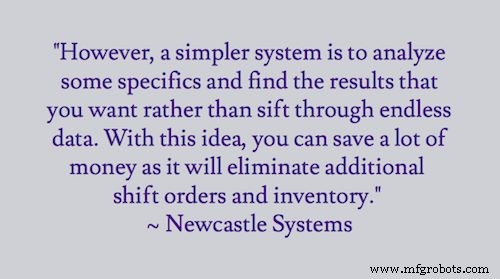
37. Link inventory levels and accuracy. “Your inventory management system will deliver a large amount of data in regards to the way products are moving within the warehouse. If you have a complex system, you will find all this information to be more than overwhelming at times.
However, a simpler system is to analyze some specifics and find the results that you want rather than sift through endless data. With this idea, you can save a lot of money as it will eliminate additional shift orders and inventory. Although, it can be difficult to integrate if your company doesn’t have inventory tracking, but it can deliver great results in the end.” – 7 Best Practices for Inventory Management for Warehouses , Newcastle Systems; Twitter: @NewcastleSys
38. Use batch tracking. “Batch tracking is sometimes referred to as lot tracking, and it’s a process for efficiently tracing goods along the distribution chain using batch numbers.
A ‘batch’ refers to a particular set of goods that were produced together and which used the same materials.
Use an automatic batch tracking system in order to enter information about all the products within your batch – keeping that information at your fingertips if you need to access it quickly, as in the case of a product recall.” – 1 0 Inventory Management Best Practices for Improving Your Business , Dear Systems; Twitter: @DearInventory

39. Use the latest software to automate warehouse functions. “The single biggest task for warehouse executives is determining fleet deployment, to match fleet deployment with cargo based on loading capacities, fuel consumption, and more. Another critical task is monitoring fleet movement.
Automating these functions, by using the latest software to intelligently route different data sets and data streams, improves accuracy and leaves the managers free to focus on other things where their core competencies and interventions would be more productive. Such warehouse automation solutions improve the efficiency, accuracy, and velocity of warehouse operations multi-fold.” – Nashiya Salim, 5 Emerging Trends that Logistics Managers Cannot Afford to Ignore, Fingent; Twitter: @Fingent
Warehouse Management Systems (WMS) Tips and Best Practices
40。 Choose a WMS with a user-friendly interface. “A WMS without a user-friendly interface will not allow your staff to maximize its capabilities. If the interface is confusing and difficult to understand, then this will surely slow warehouse processes – which is the opposite of what a WMS should be doing.
A good WMS interface should allow you to quickly access accurate warehouse quantity levels, locations of your inventory, picking and shipping data, and sales reports all within a few clicks. If the interface does not allow you to easily navigate through this kind of vital information, then that particular WMS is probably not worth your time.” – Aaron Mikel, How to Choose the Right Warehouse Management System , SkuVault; Twitter: @skuvault
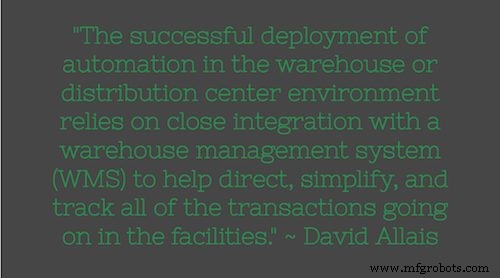
41. Closely integrate automation with a warehouse management system (WMS). “The successful deployment of automation in the warehouse or distribution center environment relies on close integration with a warehouse management system (WMS) to help direct, simplify, and track all of the transactions going on in the facilities. Even without the addition of automation, a WMS enables trained warehouse staff to achieve fast and highly accurate shipments by choreographing the most efficient pick paths and prompting specific actions each step of the way during picking and/or prior to shipment.” – David Allais, Automation in the Warehouse:Asset or Obstacle? , IndustryWeek; Twitter: @IndustryWeek
42. Conduct WMS training. “By its very nature, a warehouse management system (WMS) is designed to improve business processes. So to be effective, your WMS training effort must address not just the hardware and software, but the many ways WMS users handle goods in the warehouse.
The time and effort needed for WMS training increases as you move up the scale from bare-bones inventory management and WMS modules to dedicated, high-end WMS software.” – David Essex, Getting Started with Warehouse Management System (WMS) Training , SearchERP; Twitter: @search_ERP

43. Consider a cloud and SaaS warehouse management system. “The benefits of cloud based WMS and a SaaS system is that they allow for fast deployment, no maintenance costs, and lower IT costs. A true SaaS or software as a service eliminates the upfront capital costs of buying hardware and finding data center space to house it and drastically reduce the need for system administration. A cloud-based WMS can be customized to meet your unique business needs and offers additional features such as higher data security protocols for businesses that handle higher value inventory. Both systems are tailored to fit various types and sizes of businesses. While the SaaS solution is better suited for smaller businesses with low complexities, a Cloud WMS is more ideal for medium to large size businesses as well as those with more complexities. Irrespective of the size of your business, you can benefit greatly from a WMS that increases business efficiency and productivity.” – Rachael Afolabi, WMS for the SMB:Factors to Consider When Implementing a Warehouse Management System , Net@Work; Twitter: @NetatWork_corp
44. Consider a warehouse control system instead of a warehouse management system. “The walls between warehouse control systems (WCS) and WMS are coming down, and the former is playing a larger role in the overall management of a warehouse’s inventory. This is particularly true for companies that are putting more automation into their warehouses and DCs, says [managing director at supply chain consultancy St. Once Co., Norm] Saenz.
Historically, WCS provided the interface for material handling systems (i.e., carousels, sorters, conveyors, etc.), while WMS managed processes, people, and activities like shipments and orders. ‘We’ve worked with numerous companies that were putting in new automation along with new WCS and looking at how to leverage their WCS investments for warehouse management functionality,’ says Saenz, who expects this trend to continue as the lines between WCS and WMS continue to blur.” – Bridget McCrea, Warehouse Management Systems (WMS) / Inventory Management Technology:6 Trends for the Modern Age , Logistics Management; Twitter: @LogisticsMgmt
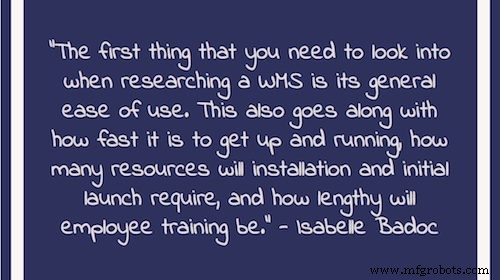
45. Evaulate the ease of installation and use when choosing a WMS. “The first thing that you need to look into when researching a WMS is its general ease of use. This also goes along with how fast it is to get up and running, how many resources will installation and initial launch require, and how lengthy will employee training be. SMEs want something that is going to installed and ready to go as fast as possible, with minimal training. The longer it takes to completely install a system, the longer it will take to catch up with the competition, and the longer precious resources will be focusing on the system rather than on business. A great system will require little to no training, even for those employees who are not necessarily tech-savvy, and will be extremely user-friendly. Easy menus and a clear dashboard, a tool that not only allows a company to rapidly optimize employee efficiency and time, but that also upgrades seamlessly across the company, and at an international level if needed.” – Isabelle Badoc, SMEs:The 4 Essential Tips for Choosing the Right WMS , Generix Group; Twitter: @GenerixGroupFR
46. Identify your key supply chain and warehouse metrics before selecting a WMS. “When you are selecting SCM and WMS ensure that the end goals of your business are identified and then measured by the system you choose. So often the best system for data entry is selected, which is admirable, but if you can’t get data/performance measures out the other end you’ve spent a lot of money for a black box you’ll struggle constantly to try and see the insides of. Be able to answer the question, “What 5 metrics will we run our supply chain or warehouse on?” with distinct items and plans to improve and sustain them over time.” – Ted Clark , as quoted in 45 WMS Selection Tips to Help You Find the Perfect Software , Explore WMS; Twitter: @ExploreWMS
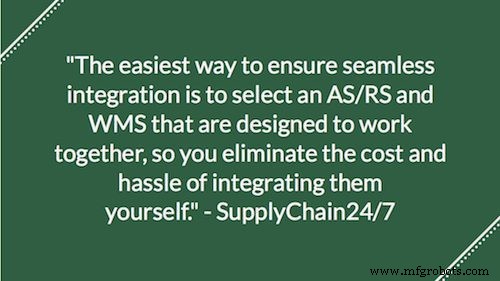
47. Integrate your AS/RS and WMS solutions. “Integrate your AS/RS and WMS solutions. These two technologies work together, each increasing the usefulness of the other. With the right equipment in place, managing a warehouse becomes much simpler and it will be easier to meet your metrics for perfect orders, accuracy, efficiency, and productivity.
The easiest way to ensure seamless integration is to select an AS/RS and WMS that are designed to work together, so you eliminate the cost and hassle of integrating them yourself.” – 11 Warehouse Operations Best Practices , SupplyChain24/7; Twitter: @SupplyChain247
48. Start simply by implementing a warehouse management system (WMS). “Start out small. Implement a Warehouse Management System (WMS) that can help facilitate the major processes within the four walls of your warehouse. From the time the truck arrives, the WMS should be able to receive product in, intelligently put it away to stocking locations, and allow you to see what and where your inventory is in the building.
My friend, you now are in control!” – Mohammad Shaban, Your Path to an Automated Warehouse:3 Things to Know , Bastian Solutions; Twitter: @BastianSolution
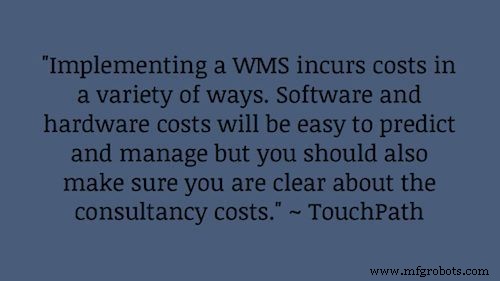
49. Understand all costs associated with a WMS. “Implementing a WMS incurs costs in a variety of ways. Software and hardware costs will be easy to predict and manage but you should also make sure you are clear about the consultancy costs. How much after sales support will your supplier provide, what will they be doing for you as part of that support and how much will additional consultancy cost?” – Top Tips for Choosing a Warehouse Management System , TouchPath; Twitter: @TouchPath
50. Understand the support costs, infrastructure, training, and implementation the WMS provider offers. “Do you own the system after buying it, or will it be software as a service? This is your decision, and every business has different drivers that you will need to consider carefully. With SAAS, you spread the cost over the full life of the product; with up-front, you will own the software and will only pay ongoing [optional] support costs.” – James Wilmer, Top Tips for Choosing a WMS , Logistex; Twitter: @logistexonline
Products and Tracking Solutions from Camcode:
- Rack Location Labels
- 条码贴纸
- Barcode Warehouse Labels
- UID Labeling
- Inventory Labels
- 过道标志
- Equipment ID Tags
- Custom Warehouse Signs
- 铝箔标签
工业技术


